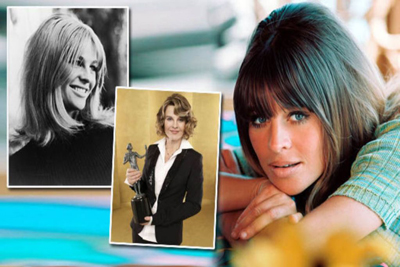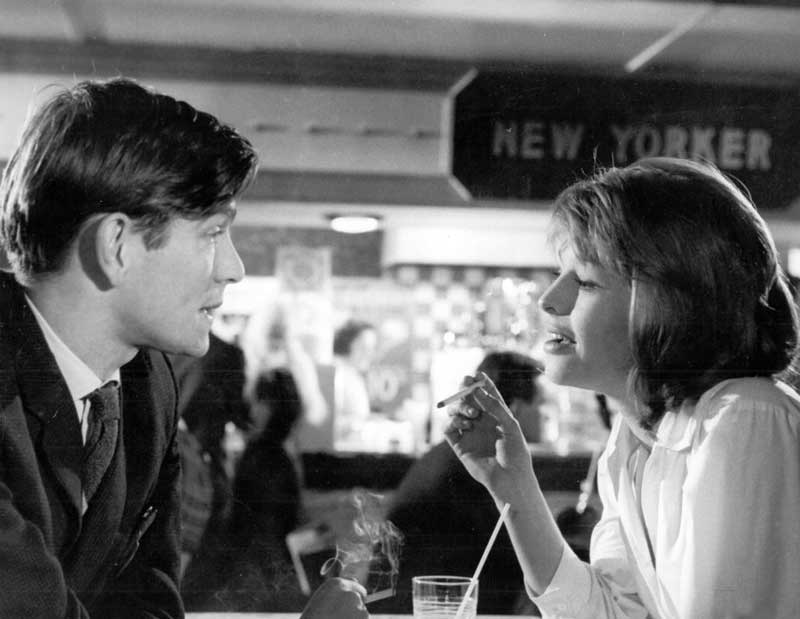
Reckoned as an icon of the Swinging Sixties, and termed as the most poetic of all actresses by Al Pacino, Julie Frances Christie was born on 14 April 1940 at the Singlijan Tea Estate, Chabua, Assam in British India. Born to a British tea planter and his Welsh wife Rosemary, a painter, Julie spent her early years in her father’s plantation. Her parents separated when Julie was a child, and after their divorce, her mother brought her to rural Welsh, where she spent her early years with her mother.
She was baptized in the Church of England, and after being expelled from two convent schools, she attended the all-girls Wycombe Court School in Buckinghamshire, when she lived with a foster mother from the age of six. She finished her studies in Paris, where she had moved to improve her French, probably intending to become a linguist. However, she was also attracted by the bohemian life of the artists in Paris and planned to become an artist, before being enrolled in London’s Central School of Speech Training. Christie made her debut as a professional artist in 1957 as a member of the Frinton Repertory of Essex. However, she was not fond of the stage, even though it allowed her the opportunity to travel abroad in the United States.

Her ultimate aim was to become a film actress, and her earliest role to gain attention was in the BBC science fiction television series A for Andromeda in 1961. She was a contender for the role of Honey Rider in Dr. No, the first James Bond film, but lost to Ursula Andress, as the producer reportedly thought her breasts were too small. She first appeared as a young and innocent girlfriend of a pathological petty thief in a comedy film Crooks Anonymous (1962), which was followed by another comedy, The First Lady (1962).
However, her breakthrough role was in Billy Liar (1963), in which her performance as the freewheeling Liz was a stunner. Selected for the role as a replacement after the original cast Topsy Jane fell ill and had dropped out of it, Julie Christie by her performance in the film created a new kind of cinematic glamour with only a handbag and an attitude instead of jewels and furs. As Liz, Julie had her first taste of becoming a symbol if not an icon of the British film and received a BAFTA Award nomination for the Best British Actress. Moved by her screen presence in the film, John Ford cast her as the devastating sexy Daisy Battles in his Young Cassidy (1965), who persuaded the hero away from a riot for some love in the afternoon.

However, Julie Christie made her breakthrough to superstardom in John Schlesinger’s Darling (1965), in which she accepted to play the role of Diana Scott at the request of the director, when the casting of Shirley MacLaine fell through. For her comprehensive performance in the role of Diana, an amoral social butterfly who underwent a metamorphosis from an immature sex kitten to a jaded socialite, Christie earned raves, along with Academy Award for Best Actress as well as the BAFTA Award for Best British Actress in a Leading Role, at the age of only 24.
According to Life magazine, 1965 was the year of Julie Christie, in which she also appeared as the romantic heroine Lara in twice Academy Award-winning director David Lean’s enormously successful adaptation of Boris Pasternak’s Doctor Zhivago (1965), one of the all-time box-office hits. During this time, at the peak of her career, Christie made it a point to resist easy money, and shunning the lure of several mediocre Hollywood projects, appeared in a dual role in Fahrenheit 451 (1966) for Francois Truffaut, a director she admired. Unfortunately, the film proved to be an interesting failure due to the director’s lack of English and the friction between Truffaut and Christie’s male co-star Oskar Werner, who resented Truffaut’s special attention to Christie.

Nevertheless, in the next year, she appeared in John Schlesinger’s adaptation of Thomas Hardy’s Far From the Madding Crowd (1967), featuring two great English actors, Peter Finch and Alan Bates. However, her portrayal of Bathsheba Everdene, the heroine of Hardy’s pastoral novel, was lambasted by the film critics, and some suggested that Vanessa Redgrave would have been a better choice as Bathsheba. But despite being a fine actress Redgrave lacked the sex appeal and star quality of Julie Christie, which makes the story of three men in love with one woman more credible. In the film, she proficiently brought to the forefront the timelessness of the heroine’s dilemmas regarding which man to marry, how to cope with love, and how to build a life in the face of uncontrollable events. In her next film, in the title role in Richard Lester’s Petulia (1968), she also perfectly counterbalanced the great performance of her co-star George C Scott. It was one of the major films of the decade, an underrated masterpiece, but it would not work without Julie Christie, and possibly no other actress could bring that unique presence and the threat of danger that crackled around Christie’s mystique aura.

Unfortunately, after her wonderful performance in Petulia, when Julie Christie was poised for greatness as an actress and as a star, she strangely gave up her aspiration to screen stardom. During 1967-1968, which represented the high-water mark of her career, she fatefully met the man who transformed her life. He was Warren Beatty, the American actor, who viewed the movie star profession as a treadmill leading to more treadmills. In their seven-year-long affair, he always undermined Christie’s career, and the honey-glow girl of the silver screen gradually became reluctant about acting. She turned down two lead roles that garnered Oscar nominations for the second choices, Jane Fonda and Genevieve Bujold. Only to fulfill her contractual obligations, she featured in Peter Wood’s In Search of Gregory (1969), a box-office flop, and after completing the shooting, spent her days with her lover in California, renting a beach house at Malibu. However, she returned in the lead role in Joseph Losey’s The Go-Between (1971), a tale of torrid and forbidden love, and earned a BAFTA nomination for the Best Actress. In the same year, she also earned her second Oscar nomination for Best Actress for her performance as a brothel madame in Robert Altman’s minor classic McCabe & Mrs. Miller (1971), opposite to her fiancé Warren Betty.

At that stage, Christie became reluctant about steady work, like her lover, which is suicidal for an actor who yearns to maintain a standing in the first rank of movie stars. She refused the offer to play the role of the Russian Empress in Nicholas and Alexandra, and again the Oscar nomination for the Best Actress went to the second choice, Janet Suzman. After a respite of two years, she appeared in the landmark of a cult classic, a disturbing psychological thriller, Don’t Look Now (1973), by Nicolas Roeg, who had been her cinematographer in Fahrenheit 451, Far From the Madding Crowd, and Petulia, in which she had a graphic sex scene with Donald Sutherland. The film received acclaim, and Christie was again nominated for the BAFTA Award for Best Actress in a Leading Role. Although her affair with Betty ended by 1974, they worked together in Shampoo (1975)span>, and Heaven Can Wait (1978).

From the early 1980s, Christie reduced her appearances in mainstream films and appeared in non-mainstream films like The Return of the Soldier (1982), in which she played the role of Kitty Baldry, a haughty society queen with a restricted view of life, and returned to her Anglo-Indian roots in Heat and Dust (1983), by James Ivory, for which she turned down the lucrative offer of a role in The Verdict by Sidney Lumet, which ultimately went to Charlotte Rampling. After that, at the end of a lengthy absence from the screen, apart from few insignificant films, she appeared as Gertrude in Kenneth Branagh’s Hamlet (1996). However, she was critically acclaimed and received a third Oscar nomination for her portrayal of the faded movie actress and unhappy wife in Alan Rudolph’s domestic drama Afterglow (1997). Apart from her brief cameo appearance in Harry Potter and the Prisoner of Azkaban (2004), her subsequent films included Wolfgang Petersen’s big-budget epic Troy (2004), and Marc Forster’s Finding Neverland (2004), for which she received a BAFTA nomination as a supporting actress.

However, perhaps her last important film is the female lead in Away from Her (2006), based on a short story by Alice Munro. It was the maiden feature film directed by the Canadian actress Sarah Polley, once Christie’s co-star, who had to persuade her for many months, before she accepted the role. Despite her aversion to acting, Christie finally performed in the film as a woman with Alzheimer's disease who forgot about her husband and fell in love with another man. Christie was nominated for both the Academy Award and Golden Globe Award for the Best Actress for her unforgettable portrayal of the role, which was a labour of love she did for a friend.
A woman with incredible seductive beauty, gifted with a deep, husky yet smooth voice, Julie Christie was chosen by Empire magazine as one of the 100 Sexiest Stars in film history. She often played women who inspire great passion in all the male characters rotating around her. In the early 1960s, she dated actor Terence Stamp, was engaged to Don Bessant, a lithographer and art teacher, in 1965, before dating actor Warren Beatty, with whom she had an intimate relationship for seven years. After getting together in 1979, Julie Christie dated British journalistDuncan Campbell for 28 years and was married to him in Nov 2007